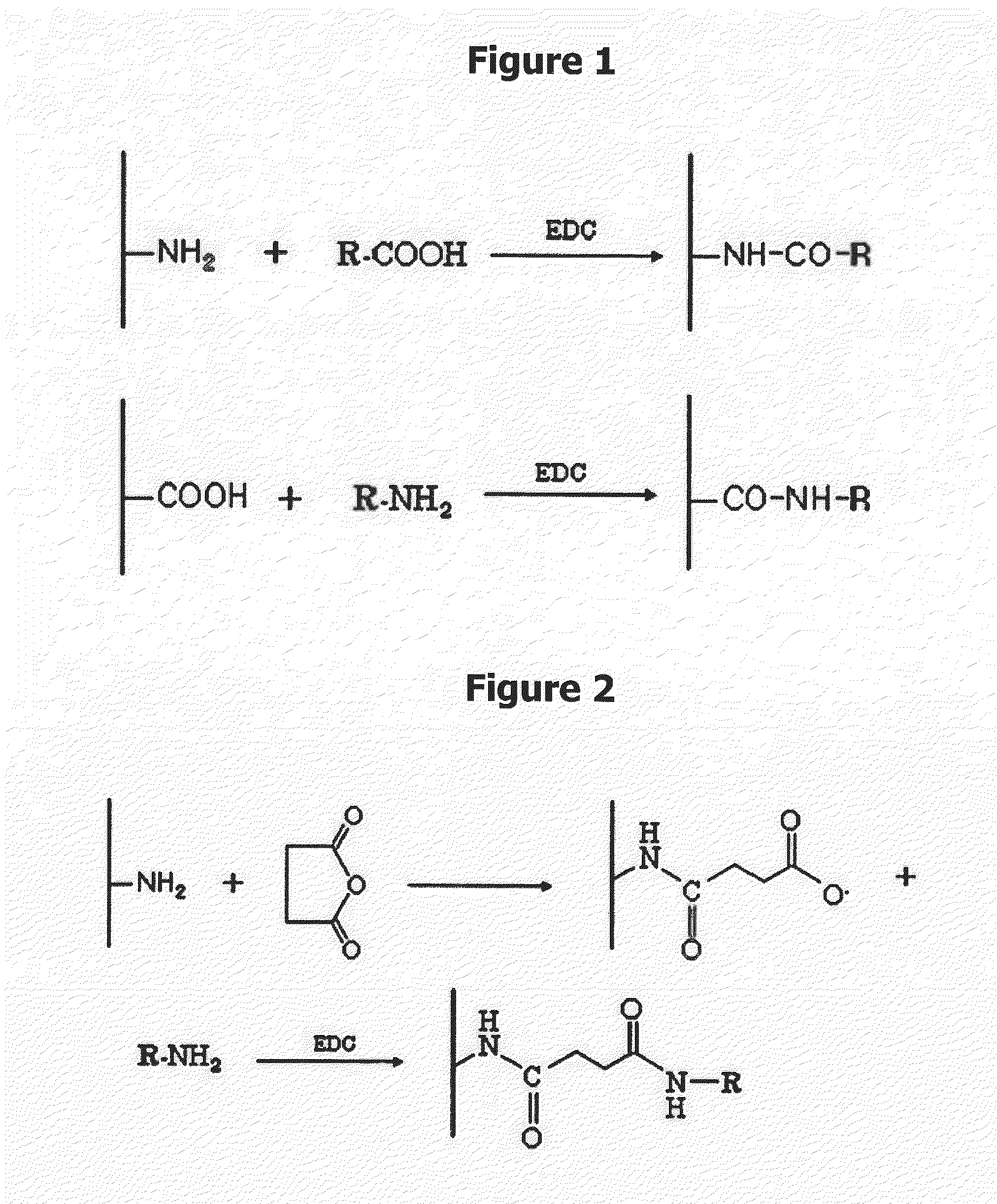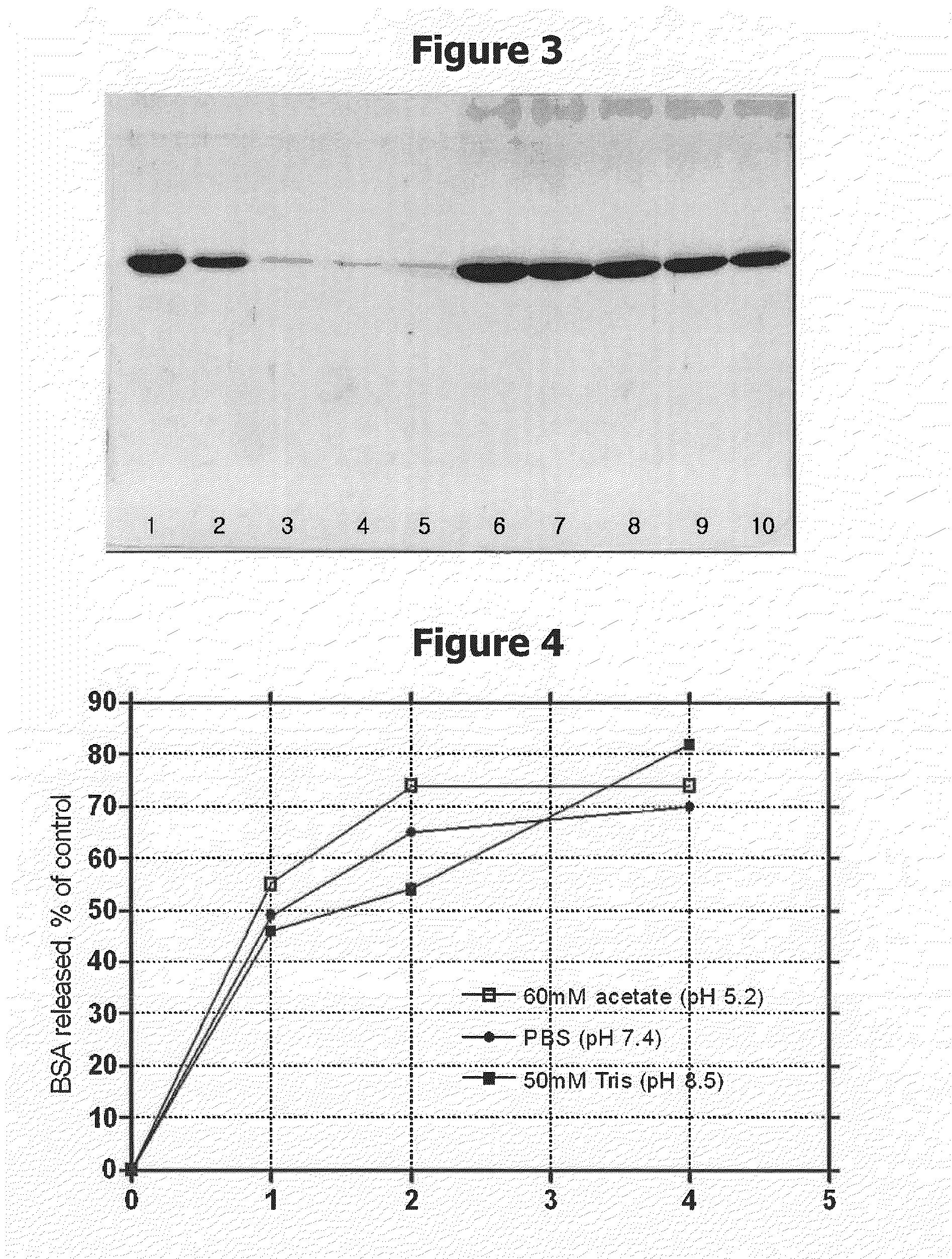Drug Delivery Carrier
a technology of delivery carrier and paclitaxel, which is applied in the direction of drug composition, peptide/protein ingredients, sugar derivates, etc., can solve the problems of poor bioavailability, low bioavailability, and difficulty in preparing paclitaxel into injection formulations
- Summary
- Abstract
- Description
- Claims
- Application Information
AI Technical Summary
Benefits of technology
Problems solved by technology
Method used
Image
Examples
example 1
Preparation of Chitosan-Benzoic Acid Conjugate
[0075]Chitosan was used as a biocompatible polymeric material. The used chitosan was a water-soluble chitosan having a degree of deacetylation of 84.5% and a molecular weight of 20-50 kD (Mirae Biotech, Korea). A 0.2% water-soluble chitosan solution prepared by dissolving in distilled water for injection was put in containers A and B, 40 mL each. Then, a 10% benzoic acid (Sigma) solution was added to the containers A and B to final concentrations of 15 mM and 30 mM, respectively. In order to induce covalent bonding between the amino group of the chitosan polymer chain and the added benzoic acid, 1-ethyl-3-(3-dimethylaminopropyl)carbodiimide hydrochloride (EDC, Sigma) was used. The conjugation reaction was carried out in a 10 mM MES buffer solution (pH 5.5). EDC was added to the containers A and B at concentrations of 30 mM and 50 mM, respectively, so that the benzoic acid could be conjugated enough. Before adding EDC and the MES buffer s...
example 2
Measurement of Protein-Adsorbing Capacity of Chitosan-Benzoic Acid Conjugate
[0076]The chitosan polymeric material conjugated with 15 mM benzoic acid prepared in Example 1 (drug delivery carrier A) was put in different containers, 2 mg (1 mL) each, and treated as described in Table 1. After centrifuging each of thus prepared solutions and collecting the precipitate, the supernatant was subjected to SDS-PAGE analysis to determine the amount of protein present in the supernatant. The protein used in this example was human growth hormone.
[0077]As a result, the drug delivery carrier A (sample A) could adsorb about 0.4 mg of protein per 2 mg of the chitosan polymer. Drug delivery carrier B (sample B), which was prepared from conjugation with 30 mM benzoic acid, showed a better protein-adsorbing capacity than the sample A. This suggests that more protein may be adsorbed as the content of the hydrophobic group conjugated to the polymer chain increases.
TABLE 1Drug delivery carrierProtein add...
example 3
Preparation of Drug Delivery Carrier Using Sodium Carboxymethyl Cellulose-Diphenylamine Conjugate or Hyaluronic Acid-Diphenylamine Conjugate
[0085]A drug delivery carrier was prepared in the same manner as Example 1 using sodium carboxymethyl cellulose, a representative anionic biocompatible polymeric material, and hyaluronic acid. Sodium carboxymethyl cellulose (25 mg) was dissolved in water and sufficiently stirred after adding diphenylamine to a final concentration of 20 mM. Then, carbodiimide (EDC) was added to a final concentration of 20 mM in an MES buffer solution (pH 5.2-5.5) with a final concentration of 50 mM. The final volume of the reaction solution was 50 mL. The mixture solution was allowed to stand at room temperature for more than 24 hours to prepare a drug delivery carrier. Upon completion of the conjugation reaction, the precipitate resulting from centrifugation was washed to obtain the drug delivery carrier. Also, another drug delivery carrier was prepared by conju...
PUM
| Property | Measurement | Unit |
|---|---|---|
| solubility | aaaaa | aaaaa |
| molecular weight | aaaaa | aaaaa |
| molecular weight | aaaaa | aaaaa |
Abstract
Description
Claims
Application Information
 Login to View More
Login to View More - R&D
- Intellectual Property
- Life Sciences
- Materials
- Tech Scout
- Unparalleled Data Quality
- Higher Quality Content
- 60% Fewer Hallucinations
Browse by: Latest US Patents, China's latest patents, Technical Efficacy Thesaurus, Application Domain, Technology Topic, Popular Technical Reports.
© 2025 PatSnap. All rights reserved.Legal|Privacy policy|Modern Slavery Act Transparency Statement|Sitemap|About US| Contact US: help@patsnap.com



